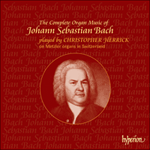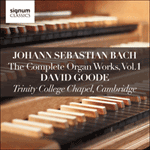There is a substantial group of works which demonstrates different approaches to the North German
Präludium. The most succinct is the ‘Little’ Prelude and Fugue in E minor, BWV533, which has the characteristic manual flourishes, pedal solos and homophonic passages making much use of suspensions and other dissonances found in the works of Buxtehude and Lübeck. But here there is a greater intensity and concentration to the rhetorical gestures, and the grinding off-beat chords of the second half of the prelude have a power not found in Bach’s models. There is considerable doubt as to how many of the great preludes and fugues, including many in
The Well-tempered Clavier, were actually conceived as pairs, but there can be no doubting the feeling of unity between these two pieces given by the taking over of the upbeat quaver figure of the prelude by the fugue subject itself. As with the ‘Little’ Fugue in G minor, the fugal working out is not particularly rigorous after the exposition, but there is a greater feeling of unity to the episodic material. Once again a final statement of the subject in the pedals gives the piece a satisfying sense of completeness.
from notes by Stephen Westrop © 1997
Eine recht umfangreiche und bedeutende Gruppe von Werken veranschaulicht die unterschiedlichen Behandlungsweisen des norddeutschen Präludiums. Das knappste Werk ist hierbei ‘Kleine’ Präludium und Fuge in e-Moll, BWV533, das über die charakteristischen Manualfanfaren, Pedalsoli und homophonen Passagen verfügt und verstärkt Gebrauch von Vorhalten und anderen Dissonanzen macht, die in den Werken von Buxtehude und Lübeck zu finden sind. Die Intensität und die Konzentration auf rhetorische Mittel sind im vorliegenden Stück jedoch stärker. Zudem verfügen die schleifenden Auftaktakkorde in der zweiten Präludiumshälfte über eine Ausdrucksstärke, derer die Vorlagen für Bachs Werk entbehren. Die Frage, wie viele der großen Präludien und Fugen, einschließlich der zahlreichen Beispiele aus dem Wohltemperierten Klavier, tatsächlich als Paare konzipiert wurden, ist sehr umstritten, doch im vorliegenden Fall ist das Gefühl der Zusammengehörigkeit der beiden Stücke, das durch die Übernahme der auftaktigen Achtel-Figur des Präludiums ins Fugenthema entsteht, wohl kaum zu verkennen. Wie bei der ‘kleinen’ g-Moll-Fuge erfolgt nach der Durchführung keine besonders strenge Fugenentwicklung, doch hinsichtlich des episodischen Materials liegt ein stärkeres Gefühl von Geschlossenheit vor. Auch diesem Stück wird durch eine abschließende Erwähnung des Themas in den Pedaltönen ein wohliges Gefühl der Einheit verliehen.
aus dem Begleittext von Stephen Westrop © 1997
Deutsch: Manuela Hübner


 Bach: The Complete Organ Works
Bach: The Complete Organ Works Bach: The Complete Organ Works, Vol. 1
Bach: The Complete Organ Works, Vol. 1
